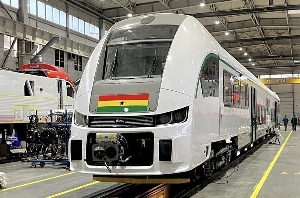Business News of Wednesday, 20 June 2012
Source: Alhassan Atta-Quayson
Newmont's Golden Years in Ghana
: Over $600million Profit in 2011 alone
By Alhassan Atta-Quayson, Third World Network - Africa
Newmont Ghana Gold - the only Newmont gold producing company in Africa - produced 566,000 ounces of gold in 2011 at "cost applicable to sales" of $474 per ounce, a considerable $117 lower than Newmont's average of $591 per ounce. This feat, from its Ahafo mine, made Africa the cheapest region/continent for Newmont to operate, in contrast to Asia Pacific where Newmont spent $639 per ounce on cost applicable to sales: $560 in South America and $594 in North America.
It is important to note that, over the past year, cost applicable to sales for Asia Pacific increased by 35% (from $474 in 2010 to $639 in 2011, probably in tandem with soaring gold prices) while that of Africa (Ghana specifically) increased by just 5%, from $450 to $474. Will Ghana's cost profile replicate a respectable rise by Asia Pacific (from 474 to 639) in 2012? Probably not, because Newmont expects Ghana cost to lie between $500 and $550 for 2012. The cost applicable to sales, which excludes amortization, depletion and depreciation, is made up of direct mining and production costs, royalties and production taxes, and other related costs. This implies that Newmont's $474 cost applicable to sales in Ghana includes royalties and all other production taxes paid to government. It is exempted from paying property tax to the local assembly and continues to be enjoying a long holiday from payment of profit tax, even as its profits leap in bounds. In 2011, Newmont set aside $137 per ounce as amortization cost.
The global gold company's average realized price for 2011 was a whopping $1,562 per ounce (compare this with $474 per ounce in cost applicable to sales at its Ghana mine)! Newmont Ghana Gold recorded a massive $1,088 per ounce in operating margin which substantially helped the multinational company produce a record $971 per ounce in operating margin in 2011. Consequently, Newmont Ghana realized $869million in net gold sales at an estimated total cost (applicable to sales) of $268million, making a colossal profit (gross) of $601million in 2011. Newmont's outputs from the Ghana mine (which contribute over 10% of total gold produced attributable to Newmont) produced at an incredibly low cost over the past years and realizing revenues and profits running through the roof is a dramatic demonstration of Newmont Ghana Gold's Golden Years in Ghana. While fast rising gold prices and quality of ore partly explain big jumps in Newmont Ghana Gold's revenues and profits over the years, another important factor (based on a study of Newmont's annual reports and those of other mining companies) is the incredibly low production cost it enjoys from exploiting Ghana's precious and non-renewable mineral resource.
Factors responsible for cheap production cost
So why has it been so cheap for Newmont to operate in Ghana (and for that matter Africa)? Two main factors are responsible here: cheap (and subsidized) inputs such as labour and energy (fuel) on one side and excessively generous fiscal regime under which it operates on the other.
Cheap and subsidized cost of inputs
Back to the first factor: cheap (and subsidized) cost of inputs. It is important to note at the outset that this factor is linked to the nature of mine that Newmont operates: currently surface mining. The mechanics and processes involved in surface mining are largely different from underground mining, which has proved to be more expensive because of further activities that are required as a comparison with other mines in Ghana would reveal. Anglogold Ashanti which operate underground mines spent over $750 per ounce in operating cost in 2011. Newmont Ghana Gold cannot dispute the fact that it has been paying low prices for several of the inputs it employs in its production processes. Fuel (petroleum products) is one such input. Fuel in Ghana is heavily subsidized as a means of cushioning the poor and vulnerable - for example the government spent GHC267.61 million to subsidize ex-pump price of petroleum products from January to September, 2011. But looking at consumption patterns in Ghana, the poor and vulnerable receive very little of this subsidy whilst big consumers like Newmont Ghana Gold take the lion's share.
So long as Newmont Ghana Gold buys its fuel from the Ghanaian market - a fact it cannot deny - to power its mining machinery (which undoubtedly consumes significant amounts of fuel for purposes of mining and servicing mining operations), its fuel costs are not only cheap but actually subsidized with taxpayers' money. In the recent past fuel subsidization has not only resulted from a direct policy but also from other factors such as depreciation of the cedi which usually fail to reflect in fuel prices. This has been the case not only from inadequate policy on the matter but also inefficient institutions. Bad politics in Ghana, which allows elites in the society to influence - in their favour - public decision and policy making in the country, cannot escape blame on this issue. It is high time the government put in place a mechanism to ensure that certain categories of fuel users (the likes of Newmont) do not benefit from a direct or indirect subsidy meant to cushion the poor and to support other strategic causes such as local enterprise development and supporting manufacturing. When the likes of Newmont continue to enjoy from such subsidy it will be extremely difficult for us to move on as a nation, if possible. The unfortunate thing, however, is that policy makers who are expected to make fundamental changes to the framework are under heavy influence of elites in the society such as of Newmont.
Another input factor which contributes a great deal to Newmont Ghana's prosperity is labour cost. There are credible reports from within the mines, including Newmont's, that Ghanaian labour in there who are routinely sent tens and even hundreds of meters into the heart of mines to dig gold are not being paid fittingly for their services. On top of this is the dramatic discrimination in terms of emoluments between Ghanaian and expatriate labour. While locals are paid just a few hundreds of dollars per month, counterpart expatriates are pocketing several tens of thousands of dollars every month. There is no reason to think that Newmont Ghana Gold is not reaping from these conditions. Another source of Newmont's low production cost, though intensely contested, is its inability to responsibly manage impacts from its mining activities. There are reliable reports in the Ghanaian media accusing Newmont of various human rights violations inflicted on people living in communities affected by its Ahafo mine (directly and otherwise). These violations include destruction of property without paying compensation, and causing various degrees of injuries and even deaths, without taking responsibility.
Stability agreement provide generous fiscal incentives
Newmont Ghana's Investment Agreement (a well-kept secret document) may include exemption from paying profit and property taxes as it has not paid these taxes since it started production in 2006. These tax elements are not only an important aspect of Newmont's low cost of production; they also represent important but forgone revenue stream for the people and government of Ghana. Should Newmont become eligible in future to pay corporate income tax, their stability agreement requires that that rate must not exceed 32.5% (the rate will not exceed 30% if Newmont lists on the Ghana Stock Exchange). This same agreement fixes Newmont Ghana's gross royalties on gold production at 3.0% (3.6% for any production from forest reserve areas, an indication that their concession includes forest reserve) for the life of any Newmont project. A recent increment in royalty rate to 5%, following soaring gold prices, therefore does not affect Newmont.
Furthermore, the government of Ghana has no stake in Newmont's operations, in contrast to other mines where the state holds 10% equity stake. Meanwhile, the Government of Ghana all of a sudden becomes eligible (as per the stability agreement) "to acquire up to 20% of a project's equity at fair market value on or after the 15th anniversary of such project's commencement of production" when Newmont's mining projects in the country are usually planned for 15 years. Will this be a move for Ghana to become responsible for reclamation and remediation? If Ghana needs 20% of a project's equity - perhaps to influence decisions such as labour-capital mix and procurement to build capacity of local contractors - why should it be possible only "on or after 15th anniversary of such project's commencement of production"?
Stability agreement a source of discrimination and frustration
While Newmont's stability agreement has been instrumental in Newmont's golden years in Ghana, it has also established itself as an important source of discrimination and heightened frustration within the Chamber of Mines. It is indubitably a highly contentious and contested issue within the mining sector and the country at large. Legitimate equity issues have been raised both in the mining industry and within the country. It is therefore relieving, though long overdue, that the Government of Ghana has established a committee to renegotiate all stability agreements signed by the government, including that of Newmont. While this is welcoming these re-negotiations might suffer from all kinds of obstructions from all kinds of quarters, and in this case, Newmont Ghana Gold will reasonably deploy all its influence either to stall the process or ensure that all fundamental changes needed to ensure that Ghana receives her fair share from the exploitation of the country's precious and non-renewable mineral resources are all together blocked. In the meantime, Newmont continues to crush the ore for gold.
Ghanaians rightly expect that all incentives that deny the country its due part of the mineral wealth and double as a source of discrimination and frustration in the mining industry will be expunged from the agreement by the end of the renegotiation. The current levels of gold price will guarantee a reasonably profitable Newmont and ensure that Newmont Ghana Gold, together with Ghanaians, enjoy the golden years. If these terms cannot be totally removed from the agreement, they must be indexed to gold prices, just as Newmont has introduced gold price-linked dividend policy which promises a dividend of $4.7 per share if the company's average realized price exceeds $2,500 per ounce (good dream). It is important for the renegotiation committee to take note of mining sector reform initiatives at both the sub-regional level and across the continent, such as the Africa Mining Vision. The committee must also consider developments in the global mining industry noting how some jurisdictions (especially those in the Global South) are re-asserting roles and stakes over their mineral resources.
NB: This article (which focuses only on the operating margin) is a precursor to an upcoming refereed article on Newmont's operations in Ghana over the past six years, with space on benefits from Newmont activities.










